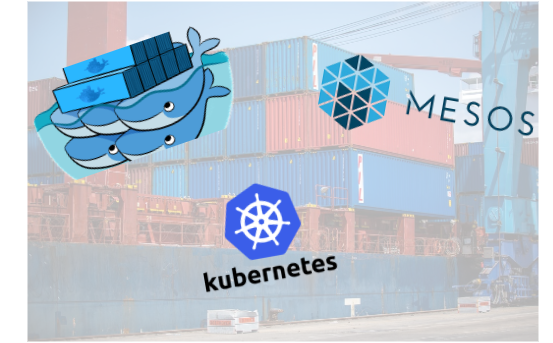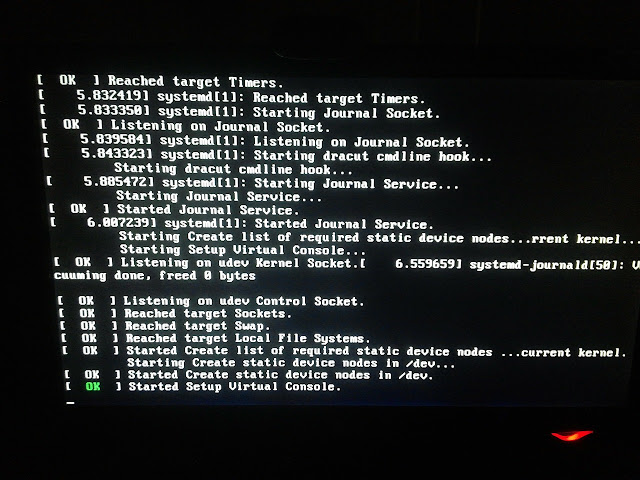Temporary Time Out
Hi folks, the Captain is taking a few weeks off as he has a brand new instance being spun up this week, if you catch my drift…  You know, the kind of instance that takes 9 months to boot… I expect to be back at the keyboard by the end of October, but don’t be alarmed if you don’t see much in the way of posts, demos, or tweets. It’s all good.
You know, the kind of instance that takes 9 months to boot… I expect to be back at the keyboard by the end of October, but don’t be alarmed if you don’t see much in the way of posts, demos, or tweets. It’s all good.
The post Temporary Time Out appeared first on Captain KVM.
Why I’m Now Using VirtualBox with Vagrant
One of the things I often tell people is, “Use the right tool for the job.” As technologists, we shouldn’t get so locked onto any one technology or product that we can’t see when other technologies or products might solve a particular problem more effectively. It’s for this reason that I recently made VirtualBox—not VMware Fusion—my primary virtualization provider for Vagrant environments.
I know it seems odd for a VMware employee to use/prefer a non-VMware product over a competing VMware product. I’ve been a long-time Fusion user (since 2006 when I was part of the original “friends and family” early release). Since I started working with Vagrant about two years ago, I really tried to stick it out with VMware Fusion as my primary virtualization provider. I had a ton of experience with Fusion, and—honestly—it seemed like the right thing to do. After a couple of years, though, I’ve decided to switch to using VirtualBox as my primary provider for Vagrant.
Why? There’s a few different reasons:
-
Greater manageability: VirtualBox comes with a really powerful CLI tool,
vboxmanage, that lets me do just about anything from the command line. In fact, the VirtualBox documentation refers to Continue reading
Test-driving arbitrary data publishing over BGP
BGP is a routing protocol known for its strength in scaling and resilience. It is also flexible and extensible. With its Multi-Protocol extension BGP can support distribution of various data types. Still to extend BGP for every new route data type requires introduction of new address family(AFI/SAFI) and making BGP aware of the new data … Continue reading Test-driving arbitrary data publishing over BGPIntegrating RHV & OpenStack with Neutron
Hi folks, I recently posted an article on one of the official Red Hat blogs about the new Neutron integration between RHV and RHOSP. I have to say it’s very cool and might change the way you look at networking capabilities in RHV, at least if you’re also using RHOSP in the same data center.
As a side note, I’ve mentioned my friend and colleague, Tony James in recent posts and he makes another appearance this week. He helped pull together the configuration steps as well as the demo that we recorded. Big kudos to to “Big T”.
Back to the actual integration. If you don’t want to look at the other article, the condensed version of “why should you might care” is as follows:
- Run applications across RHV & RHOSP – front end of the app on RHOSP and the back end on RHV using the Neutron integration to bridge the network gap.
- Add SDN capabilities to RHV via the Neutron integration, even if the app only exists in RHV.
- Manage the SDN network topologies for both RHV and RHOSP from a single management space (web or programmatic).
Those are the 3 big use cases, in a nutshell. If Continue reading
Docker Networking: Introduction to Microservices and Containers
Dinesh Dutt started his excellent Docker Networking webinar with introduction to the concepts of microservices and Linux containers. You won’t find any deep dives in this part of the webinar, but all you need to do to get the details you’re looking for is to fill in the registration form.
Modern Storage Software Erodes Resistant Data Silos
With the record-breaking $60 billion Dell/EMC acquisition now complete, both of these companies and their customers now have more options than ever before to meet evolving storage needs. Joining forces helps the newly minted Dell Technologies combine the best of both worlds to better serve customers by blending EMC storage and support with Dell pricing and procurement.
But there is some trouble in paradise. Even when sold by the same vendor, most storage systems have been designed as secluded islands of data, meaning they aren’t terribly good at talking to each other.
In fact, this silo effect is exacerbated …
Modern Storage Software Erodes Resistant Data Silos was written by Timothy Prickett Morgan at The Next Platform.
Test-driving EVPN route publishing with GoBGP
In recent times there has been a lot of interest in tunnel based L2 networks, especially for Cloud Networks implemented with VXLAN. The tunnel based networks were initially proposed with the idea of alleviating the 4k limit imposed with VLAN based networks. EVPN based VXLAN tunneled networks use BGP as control plane for L2 learning. … Continue reading Test-driving EVPN route publishing with GoBGPIs the next big thing VR, AI and Robotics? Or is it already here. Recap of AT&T Shape 2016
NFV Platforms with MirageOS Unikernels
Wassim Haddad is at Ericsson Silicon Valley where he currently works on distributed cloud infrastructure. Heikki Mahkonen and Ravi Manghirmalani work at Ericsson Research at Silicon Valley in the advanced Networking and Transport labs. The Ericsson team has a diverse background in different NFV, SDN and Cloud related R&D projects.
The push towards NFV
The Network Function Virtualization (NFV) paradigm breaks away from traditional “monolithic” approaches, which normally build network functions by tightly coupling application code to the underlying hardware. Decoupling these components offers a new approach to designing and deploying network services. One that brings a high degree of flexibility in terms of separating their lifecycle management and enabling much more efficient scaling. Moreover, the move away from specialized hardware coupled with a “virtualize everything” trend is fuelling operators and service providers’ expectations of significant cost reductions. This is undoubtedly a strong motivation behind NFV adoption.
Current NFV market trends point towards two key technologies: Cloud Orchestration (e.g., OpenStack) to provision and manage workflows, and Software Defined Networking (SDN) to enable dynamic connectivity between different workflows as well as network slicing. In parallel, there is also a strong desire to migrate from virtual machines towards microservice enablers, Continue reading
A simple metadata server to run cloud images on standalone libvirt :: KVM Hypervisor
With all the interest in Cloud Computing and virtualization, the OS vendors are providing ever more easier ways to deploy VMs. Most of them now come with cloud images. This makes it really easy for users to deploy VMs with the distro of their choice on a cloud platform like OpenStack or AWS. Here are … Continue reading A simple metadata server to run cloud images on standalone libvirt :: KVM HypervisorCyberChaff: HaLVM unikernels protecting corporate networks
Unikernel technologies, specifically the libraries, are applicable in many ways (e.g. the recent Docker for Mac and Windows products). However, unikernels themselves can enable new categories of products. One of the most prominent products is a network security tool called CyberChaff, based on open source HaLVM unikernels. Today Formaltech, a Galois subsidiary, revealed that Reed College is one of their happy CyberChaff users!
Defending a Network With CyberChaff
CyberChaff is designed to detect one of the early and critical steps in a security breach: the point when an attacker pivots from their initial entry point to the more juicy parts of the network. This step, the pivot, typically involves scanning the network for hosts that may be better positioned, appear to have more privileges, or are running critical services.
To impair this step of the attack, CyberChaff introduces hundreds (or thousands) of false, lightweight nodes on the network. These hosts are indistinguishable from real hosts when scanned by the attacker, and are each implemented as their own HaLVM unikernel. See the diagram below where green nodes are the real hosts and the orange nodes are HaLVM CyberChaff nodes. This means that an attacker is faced with a huge Continue reading
Enable nested virtualization on supported hardware. (Fixing WARNING KVM acceleration not available, using ‘qemu’ issue)
 |
| Source: http://samadhisoft.com/wp-content/uploads/2009/05/nested-boxes.jpg |
 |
| © Warner Bros |
SSH Jump Host and Connection Multiplexing
Jump Hosts While working with libvirt as my primary hypervisor to launch test VMs I need a way to connect to the VMs easily over SSH. As libvirt uses private network and SNAT for connecting the VMs to external world getting SSH access to the VMs requires Port Forwarding or DNAT. I recently came to … Continue reading SSH Jump Host and Connection MultiplexingGotchas to configuring Calico with Docker
 |
| © Calico project - Metaswitch |
Docker networking has seen a lot of improvements both in the native libnetwork library as well as other projects & solutions. Docker container networking especially across two physical hosts is an interesting problem with various solutions out there with their own pros and cons. You could go with flannel, a L2 overlay, VXLAN overlay to facilitate multi-host container networking or choose a pure L3-only solution like Calico. Speaking of the various choices for container networking I came across this article that compares the network glue : underlay/ overlay solutions using different parameters. Feel free to check that out if you want to get an idea into what each of these (VXLAN, flannel & Calico) offer but then of course making your own comparisons and benchmarks will not only provide with the differences/features you are looking for but also Continue reading
Running docker containers with native L2 networking & DHCP
 |
| License: CC from Docker Blog / Dave Tucker |
There are cases where a container needs to come up on a pre-existing bridge or a user defined bridge. This can be achieved by giving the --net option during docker run or configuring docker daemon options pre to docker engine boot. Creating an image with dhclient installed in it & programmed to start automatically is one way of doing l2-dhcp from the physical network infrastructure. There are other ways of doing this - macvlan, ipvlan or manually plugging in a veth pair between the docker container namespace and the host network stack. I will describe the former method here. macvlan and veth pair addition methods are described here [Cr1].
Step 1: Build a docker image with the required set of tools. An example is given below. This installs dhclient, netutils and iputils along with running sshd. User root’s password is set to centos using the start.sh script. Dockerfile & script source attributed to maxamillion (github link)
FROM centos:latest
MAINTAINER Continue readingTest-driving multiboot on Raspberry Pi – without BerryBoot/Noobs
Recently I got a Raspberry Pi 3 board and wanted to try out various OS options on it. I realized quite quickly that to try a new OS I would need to block copy (dd) the OS image to my SD card every time. I am running short on micro SD cards and it has … Continue reading Test-driving multiboot on Raspberry Pi – without BerryBoot/NoobsTest-Driving OSPF on RouterOS – Interoperability
So I wrote about OSPF on RouterOS in my previous post. It was a nice experiment to learn about routing protocols. I wanted to take it a little further and test Interoperability of RouterOS with other open source solutions. This post is an update from the previous one and I will add OSPF neighbor nodes … Continue reading Test-Driving OSPF on RouterOS – InteroperabilityTest-driving OSPF on RouterOS
I came across RouterOS by MikroTik© which provides advances routing protocol support. What is more amazing is they provide a RouterOS in a virtual form-factor called Cloud Hosted Router (CHR) that can be installed on hypervisors like KVM/VirtualBox/VMware. Please look at licensing model at http://wiki.mikrotik.com/wiki/Manual:CHR#CHR_Licensing This is perfect for learning purposes and experimenting at home. … Continue reading Test-driving OSPF on RouterOSKernel Programming 101 – Creating your own Linux Kernel Module
Have you ever wanted to write your own kernel module? This multi-part blog post will talk about creating your first kernel module, using the proc file system, gathering and updating statistics and will cover topics such as your kernel as a menu items to menuconfig, setting defaults in the kernel config, registering network callbacks for specific types of packets taking Cisco CDP as an example and some tips-tricks in writing and debugging kernel code. A lot of my own learning has been through blogs and experiments. One source that is really great and does summarize a lot of what my blog will talk about and more is TLDP (The Linux Documentation Project).
Today programming involving systems is about providing the flexibility and pace for software development by providing user space APIs that interact with the linux kernel through system calls. This approach also provides the abstraction needed to carve out the complexity in direct kernel programming. So before we dive into kernel programming-101, lets answer this question - Why Kernel Programming?
When there's need to perform operations without cpu cycles wastage and/or reduce user space copy overheads, kernel programming suits the bill. Taking networking and linux networking stack as Continue reading
ContainerWorld2016 conference in review – Part II (Container Orchestration)
 |
| © Arun Sriraman |
When talking about containers and orchestration, as Adrian put it, one can think of two methods or paradigms of interacting with any system - imperative where you have complete control on how you want the system to work along with configuration knobs accessible to you at every step and declarative where you describe the outcome and the system automates everything for you making it simple and easy but giving you less flexibility and configurability. The degree of configuration control and ease of use are two important factors that Continue reading

